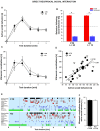Impaired Object Recognition but Normal Social Behavior and Ultrasonic Communication in Cofilin1 Mutant Mice
- PMID: 29515378
- PMCID: PMC5825895
- DOI: 10.3389/fnbeh.2018.00025
Impaired Object Recognition but Normal Social Behavior and Ultrasonic Communication in Cofilin1 Mutant Mice
Abstract
Autism spectrum disorder (ASD), schizophrenia (SCZ) and intellectual disability (ID) show a remarkable overlap in symptoms, including impairments in cognition, social behavior and communication. Human genetic studies revealed an enrichment of mutations in actin-related genes for these disorders, and some of the strongest candidate genes control actin dynamics. These findings led to the hypotheses: (i) that ASD, SCZ and ID share common disease mechanisms; and (ii) that, at least in a subgroup of affected individuals, defects in the actin cytoskeleton cause or contribute to their pathologies. Cofilin1 emerged as a key regulator of actin dynamics and we previously demonstrated its critical role for synaptic plasticity and associative learning. Notably, recent studies revealed an over-activation of cofilin1 in mutant mice displaying ASD- or SCZ-like behavioral phenotypes, suggesting that dysregulated cofilin1-dependent actin dynamics contribute to their behavioral abnormalities, such as deficits in social behavior. These findings let us hypothesize: (i) that, apart from cognitive impairments, cofilin1 mutants display additional behavioral deficits with relevance to ASD or SCZ; and (ii) that our cofilin1 mutants represent a valuable tool to study the underlying disease mechanisms. To test our hypotheses, we compared social behavior and ultrasonic communication of juvenile mutants to control littermates, and we did not obtain evidence for impaired direct reciprocal social interaction, social approach or social memory. Moreover, concomitant emission of ultrasonic vocalizations was not affected and time-locked to social activity, supporting the notion that ultrasonic vocalizations serve a pro-social communicative function as social contact calls maintaining social proximity. Finally, cofilin1 mutants did not display abnormal repetitive behaviors. Instead, they performed weaker in novel object recognition, thereby demonstrating that cofilin1 is relevant not only for associative learning, but also for "non-matching-to-sample" learning. Here we report the absence of an ASD- or a SCZ-like phenotype in cofilin1 mutants, and we conclude that cofilin1 is relevant specifically for non-social cognition.
Keywords: ADF/cofilin; USV; actin depolymerizing factor; cognition; dendritic spine; memory.
Figures



References
-
- Bell R., Munro J., Russ C., Powell J. F., Bruinvels A., Kerwin R. W., et al. . (2000). Systematic screening of the 14-3-3 eta (η) chain gene for polymorphic variants and case-control analysis in schizophrenia. Am. J. Med. Genet. 96, ,736–743. 10.1002/1096-8628(20001204)96:6736::<AID-AJMG8>3.0.CO;2-2 - DOI - PubMed
LinkOut - more resources
Full Text Sources
Other Literature Sources
Molecular Biology Databases
Research Materials

